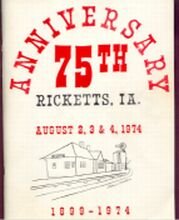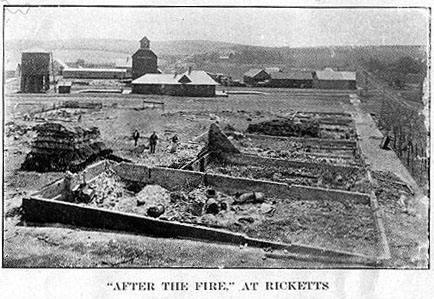History of Ricketts
The Beginning
June 1872 saw the final formation of the county townships as we know them now. Soldier, Morgan, Otter Creek, and Hanover were those last townships established. The town of Ricketts would eventually spring up in Soldier Township as a consequence of a new railroad that was built by the Boyer Valley Railroad Company, beginning in 1899.
The first elections in Soldier township were held in Barretts schoolhouse, and the school census of 1873 showed 32 students, and the 1885 census enumerated 550 people in Soldier township.
The Boyer Railroad company began building a branch line in the spring of 1899 from Boyer that would extend southwest through the county, ending at Mondamin in Harrison County. It is along this railroad line that Ricketts would spring up, several miles north of Charter Oak. The first train service on the line occurred July 24, 1899.
The first site selected for Ricketts was the southwest corner of Section 3 in Charter Oak Township, but the farmer who owned the land would not sell the property. Thus, the current location in Sections 35 and 36 in the southeast corner of Soldier Township.
The Denison Newspaper of that year states that "Charter Oak people are practically convinced now that nothing can be done to get the new North West line to strike the town and that they will settle down to hold the town to it's present advantage and make it impossible to grow much of a town north of here". It was not known at that time where the new town would be located, but if they put in too many stations it was certain "towns would become too numerous to be more than crossroads and Charter Oak isn't afraid of them. They can't build up towns to compete with The Oak".
Mr. Greg F. Schroeder was depot agent in Ricketts from 1918 to 1924. While he was there, two steam passenger trains and two steam freight trains came through Ricketts daily.
The Town Name
Julius Christiansen believes the town got its name from a bachelor named Ricks. The people talked about naming the town Sciford, but Mr. Sciford didn't want it named after him. Since Mr. Ricks had died about that time, they named the town after him. He had lived north of Ricketts on the land currently farmed by Verdell Clausen.
The First Businesses
Otto Baak recalled there were no stores or buildings in Ricketts at the time they were building the railroad, but it didn't take long for three shacks to go up and barrels of whiskey brought in, all of which did a booming business. By fall of 1899, he said there were stores built in the town and the first train went through.
Julius Christiansen said that the first house was the Boyens house which was the original Sciford farm house. The first store in Ricketts stood where Ivan Ewoldt's house now stands, was built by George Sciford, Sr., and was run by a man named Schmidt. Later the store was run by August Baak and the family lived upstairs. The first telephone office was in the two rooms in the upstairs.
The first hotel and saloon stood where Vic's station now stands. The second hotel was where the bank is today. A blacksmith shop was run by Conrad and Wallis Summers and by 1911 was in the hands of Max Wulf.
There were two lumber yards. Nye, Schneider and Jinks owned one and it was managed by a Mr. Stempleton, who also managed the (grain) elevator (business). The other lumber yard was the Green Bay, which was where Carl Schnoor's building is now and they also had a (grain) elevator. Nick Vollersen managed both of the Green Bay operations. There was also a tie barn for horses in back of Albert Grell's house.
There was a shoe shop run by a Mr. Reimer, a saloon run by Paul Voss, a barber shop with George Conyers and John Fiddler, and Gus Rickerts' hotel.
There were two water wells in town, one where it is today. Julius Christiansen told about the old water tower which was made of wood and he thought that it had never been cleaned until he took it upon himself around 1920. He said there was two inches of slime in the bottom along with mud and dead birds.
The German Savings Bank of Ricketts was organized in 1901 by James F. Toy, Charles Robertson, E. E. Springer, John Dalieu and Adolph Meyer. The capital stock was $10,000. The Officers were James F. Toy, president: Charles Robertson, vice-president: P. F. Fiene, cashier.
The Ricketts bank was closed only one day during the depression. Julius Christiansen, director of the bank at that time and P. H. Claussen, the bank's cashier, drove to Des Moines to visit the state comptroller to show cause why the bank, The Farmer's Savings Bank as it was called at this time, should not be closed. The bank was not closed, but for this one day.
Fire of 1907
A fire consumed most of the business section in 1907. The fire started around 2 or 3 in the morning in Pete Petersen's saloon in the harness shop which was in the back. Anna Mundt said that her dad asked her to light a lamp which was not needed as the flames lit everything up. Mrs. Andrew Kuhlman fainted and they carried her up to the store and laid her on a feather bed. Louie Johannsen, when the fire first broke out, got so excited he forgot to put on his shoes before he came running to help. He was on the roof of the machinery building fighting the fire when his wife, Emma, came carrying his shoes to him. Anna Mundt said she helped pump water until the well went dry. The fire kept burning.
A hotel was built after the fire by Thomas Munster and Nick Vollerson called the Borchman Hotel and Saloon. Shortly after the hotel was in business, Anna (Munster) Mundt and her brother Peter, operated a "Butcher Wagon" for a few years. The wagon, drawn with horses, held a large closed box packed with ice to keep the meat cool. They did most of their butchering at Schau Town. The south part of the hotel was used for the meat market at that time.
Schools
Prior to 1913 children attended one of 9 country schools in Soldier Township or one of the parochial schools at the Immanuel Lutheran School in Soldier Township or the German Evangelical Lutheran School of Hanover Township.
In May, 1913, lots were purchased in town for $250 and deeded to The Ricketts Independent School District in order for Ricketts to have a school within the town limits. The first board of directors included T. J. Munster, president; P. H. Claussen, secretary; and Otto Hennings, treasurer.
By fall 1913 a one-room school house was built and the first teacher, A. K. Wilkens, was hired for a salary of $75 per month. The average cost of tuition per pupil was $3.07 per month.
The first children to enroll in the school were:
- Primary Division
- Albert Baak, age 6
- Hans Schaw, age 7
- Arnold Claussen, age 6
- Lizie Detleff, age 7
- Eddie Detleff, age 5
- First Intermediate Division
- Mildred Snow, age 9
- Willie Kuhlmann, age 8
- Arlene Davis, age 7
- Ella Detleff, age 6
- Alfred Rix, age 10
- Eddie Grell, age 7
- Minnie Grell, age 6
- Second Intermediate Division
- Paul Rickert, age 11
- Ellen Rickert, age 10
- Emma Carstensen, age 12
- Anna Schau, age 10
- Hilda Claussen, age 10
- Katie Claussen, age 8
- Clara Kuhlmann, age 10
- Walter Baak, age 8
- Cecil Davis, age 10
- Advanced Division
- Alta Munster, age 15
- Laura Munster, age 10
- Elmer Munster, age 13
- Bernhard Carstensen, age 14
- Henry Detleff, age 12
- Clara Baak, age 12
- Marjorie Jones, age 11
- Floral Snow, age 11
Upon completion of his employment, Mr. Wilkins must have been pleased with his instructional abilities as he wrote the following comments: "Success to my successor. The children of this school are exceptionally trained."
The following teachers taught in the Ricketts School District:
- 1913-1914 A. K. Wilkins
- 1914-1917 Ethel Beals
- 1917-1918 Marguerite Harvey
- 1918-1919 Albertine Ringrose
- 1919-1920 Mary Hallstein
- 1920-1922 P. M. Haufle
- 1922-1923 J. R. Stenske
- 1923-1925 Ann S. Aronson
- 1925-1926 Thelma Corey
- 1926-1927 Agnes Town
- 1927-1928 LuVerne Tucker
- 1928-1930 Hannah Hefferman
- 1930-1933 Myrtle Taylor
- 1933-1934 Margaret E. Bremmer
- 1934-1935 LuVerne Baak
- 1935-1938 Margaret Pautsch
- 1938-1942 Della Olson
Churches
Separate histories for the Immanuel Lutheran Church in Soldier Township and the St. Paul Lutheran Church in Hanover Township that served the Ricketts area are presented in the Churches category of our Database page.
Ricketts Opera House
In 1920 the Ricketts Opera House Company was purchased from Carl and Caroline Grell, for the sum of one dollar and other valuable considerations. The opera house was sold at a public sale in March and the house was purchased in addition to the moving picture machine and the fixtures for $2,250. The first shareholders meeting on record was Feb. 14, 1922. The financial statement showed a balance of $331.92. In October of 1941 a meeting was held to discuss how to interest more parties in the opera house and to raise money for improvements and repairs on the building. The last meeting was held in 1943 and it was decided to dissove the company, since the opera house had burned down in December of 1942. The cash balance on hand was paid to the sharholders and the lots allowed to be sold for taxes.
Selected Items from Town Minutes of Ricketts
April 21, 1902 -- Hy Timm was appointed a committe of one to look up a location for a jail and to find the cost of the same.
April 28, 1902 -- Special meeting to find out about jail. Committee didn't show up - meeting adjourned until May 3.
April 23, 1906 -- Special session called for purpose of aiding San Francisco earthquake sufferers. Donated $25 to the Red Cross Society
May 7, 1906 -- Decided to condemn the sidewalks of P. C. Petersen and those of George Krohnke. They were given 30 days to get them repaired.
Source: Abridged from material in the Ricketts 75th Anniversary (1899-1974) book kindly supplied to us by Michael Buck and The History of Crawford County, published in 1911.




